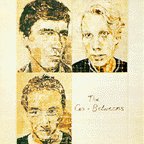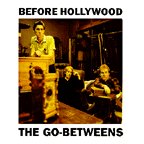|
|
|
High August Moon Part One: 1978 - 1984 During the last months we've witnessed the second coming of The Go-Betweens, who originally saw the light of day back in the late 70s, and called it a day just as the 80s turned 90s. I must admit to be slightly sceptical when hearing of bands that re-unite and decide to try a comeback after being history for some years. Especially when it comes to old favourites of mine, such as The Go-Betweens. Was this a decision of theirs to do just one small tour (of Europe, and Australia?), or is this to be permanent, maybe also to include recordings of new material? Being far from high-blown, this was just meant to be a brief gathering of old and very dear friends. Who simply likes being together, playing and performing. Actually they reunited in May last year, in Paris, for a one-off gig celebrating the 10th Anniversary of the French music magazine Les Inrockuptibles. The two main-men of the band, Robert Forster and Grant McLennan, have both made a line of solo albums. Without achieving fame and fortune, only to experience the manifestation of their underground stardom. Their reformation was maybe inspired by the song Dusty In Here from their second album, Before Hollywood: Like a Ghost, A Ghost of Something Old 
Yes, it's been almost 20 years since The Go-Betweens got together, in Brisbane, Australia. After befriending at Queens University, Brisbane in 1976-7, the two song-writers to be - Forster (lead and rhythm guitar, vocals) and McLennan (bass, guitar, vocals) - decided to form a band inspired by the song-writing abilities of Bob Dylan, the simplicity of The Velvet Underground and the DIY spirit of the punk explosion. In december of 1977 The Go-Betweens was born, given birth to by two youngsters with matching egos and a certain confidence: "We were two guys hanging around Queens University in Brisbane, with our cinema magazines and records by Ry Cooder, the Ramones and Jonathan Richman. I was 18 or 19, I was hanging out with the coolest students but I didn't think anybody was as cool as me. Initially i found Grant pretty arrogant - that hasn't really changed. It was the first time I'd met anybody as cool and intelligent as me." (R.Forster) In mid-78 they released their debut single, the classic Lee Remick, on their own Able Label. During the first couple of years they made use of several session drummers (as well as additional instrumentalists), but were in fact just a duo. They even appeared live as a two-some now and then, and built up a following of devoted admirers. After another single - People Say - the year after, they went to the UK, where they've been noticed both by the music press and some of the independent labels. In 1980 they recorded two songs which were released as a single, I Need Two Heads / Stop Before You Say It, by the Scottish label Postcard (home of Orange Juice, Josef K, and Aztec Camera). After a couple of well-recieved gigs in the UK, they returned to Australia, to meet with who was to be their permanent drummer, Lindy Morrison. 
Starting to work with new material to become their first album, the trio
rehearsed and toured Australia. They also impressed the record company Missing
Link enough to be signed, and in early 1982 their debut album, Send Me A
Lullaby, was ready for release. This was also the debut for Grant as a singer,
an affair Robert so far had been taking care of. From the very start all their
songs were bearing the signature "written by Forster/McLennan", with each song's
lyric individually credited to either Robert or Grant. During the career of The
Go-Betweens there've been quite some remarks about this song-writing
partnership, with the possibilities of opposition and conflicts that may follow.
And often there has been made comparisons to another duo of writers in history of
pop: Lennon - McCartney. One might say this split-leadership of a band mostly are being fatal. Yet it also could be seen as some sort of competitiveness, which might as well be good for the creativity and, further, the quality of what is being created. Then again, Forster and McLennan's differences in style of composing were a perfect match, when speaking of complement and contrast. With McLennan being the more melodic one, while many of Forster's songs had a rougher expression, quite often "dressed" in staccato arrangements and rhythms. This could also be the description of their vocal styles; Grant's voice being soft and tender, while the voice of Robert is being more hard and metallic, not unlike the singing of Tom Verlaine. Anyway, their debut album showed, in spite of maybe sounding a bit thin and incomplete, two young men with a certain talent for pop-songs on the melancholic side, but with plenty of delicate tunes and hidden charm. 
When going to promote their first LP they headed for England again. Rough Trade Records took care of the European distribution, and the trio arrived in London and was greeted by certain critical acclaim in the music papers. After touring Europe that summer, in the autumn they were ready to start recording another album. Before Hollywood was recorded in London, and The Go-Betweens were taking another step in the right direction. The album was released in the spring of 1983, along with the most brilliant single, Cattle And Cane, one of the highlights of the record. Once again Forster and McLennan showed their capability of writing powerful songs, accompanied by bitter-sweet lyrics of a very poetic and literary nature. Robert once studied English literature, and it seems like they both were into film as well, hence the albums roguish title: I told the heads I recall a bigger brighter world, A world of books Yet again the press was excited, even more excited than after their first album, and the record spent several months in the indie charts. Before Hollywood was claimed to be a "rare masterpiece", and listeners were fascinated by the simplicity and strength of their music. They now decided to expand the trio, by recruiting an old friend from Brisbane, Robert Vickers, to be their permanent bass-player. They were touring Australia, Europe, and the American East-coast quite successfully, and managed to get a deal with the major label Sire (Warner). Was this to be the way to the peak of a commercial break-through for The Go-Betweens? Album #3, Spring Hill Fair was recorded in France, and was very well recieved when released in September of 1984. But the "success" was relative, as seen from a major record company's point of view, hoping to sell loads of albums. I guess The Go-Betweens themselves were also somewhat disappointed when not selling a larger scale of records. This lead to a break-up between band and company, and once again The Go-Betweens were treading water. Waiting for the world to understand. Based in London they started working on, and recording new material, being their own masters. They felt that London was far more a centre of the music-biz than Brisbane down under. And they just weren't ready for giving in and moving back home. Not yet. You'll find part II (1985 - 1990) under the October moon. Copyright © 1997 Håvard Oppøyen
|
| © 2011 Luna Kafé |